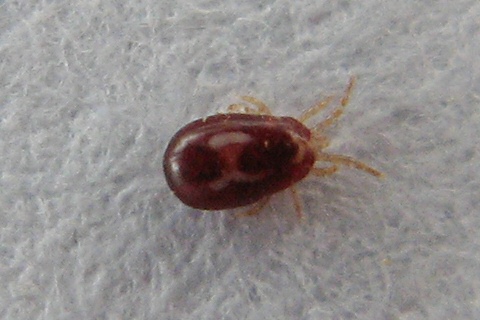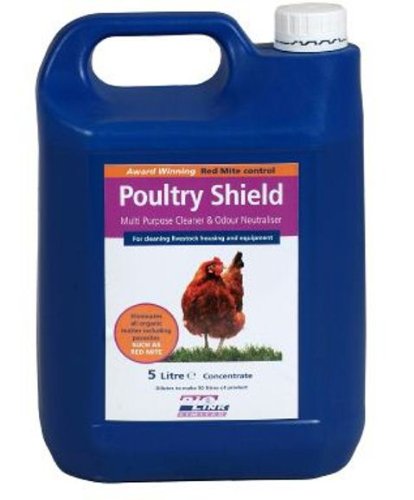 Red Mite infestation is one of the main problems you will have to deal with when you keep chickens. This post will help you to understand what red mites are, how they affect your chickens and how you go about getting rid of them.
Red Mite infestation is one of the main problems you will have to deal with when you keep chickens. This post will help you to understand what red mites are, how they affect your chickens and how you go about getting rid of them.
What are red mites?
Red mites are tiny parasites belonging, like spiders, to the arachnid class of animals. They are extremely small in size, about 1mm in length and live from drinking th blood of birds. Despite their name are usually pale grey in colour, only turning red once they have drunk the blood of the bird they are feeding off. The colour, of course comes from the blood of their victim being visible through their body.
Red mites are generally nocturnal and usually feed at night when their victims are resting. Unlike fleas, they don’t necessarily live on the hens themselves, as there is the possibility that they could end up being the food rather than the feeder, instead they often retreat to safety during the daylight hours finding shelter in dark areas of the coop. If you own a coop with a tarpaulin covered roof, you will often find that the red mite lives in the gap between the tarpaulin and the wood.
Away from the chicken, the red mite with will mate and breed. As the life cycle of the red mite is only a week long, you will find that breeding takes place prodigiously and this means eradicating red mites can be a long and difficult process as it only takes a small number of mites a short time to reinfest a coop.
Red mites are at their most active during the warmer spring and summer months and may seem to disappear during the winter months – though this is due to the eggs remaining dormant during the cold weather and hatching in when the temperatures increase.
How dangerous are red mites to chickens?
Red mites pose a significant health risk to your entire flock, particularly young or already ill chickens. In small numbers, they cause your chickens to be uncomfortable and restless. Hens trying to deal with itching and biting might shed or pluck their own feathers. Restlessness may put them off laying too.
However, it’s in the nature of red mites that their numbers won’t stay small for long if untreated and this is where the real serious issues arise. Large numbers of red mites feeding on small numbers of chickens will slowly cause your chickens to become anaemic and vulnerable to other infections. Eventually a chicken will die.
Being blood sucking parasites, red mites also pose other health problems both to chickens, other animals and humans. They can carry salmonella, other diseases and can also cause dermatitis to humans as well.
How to spot red mites?
Before discussing the symptoms of red mite infestation in chickens, it’s important to point out that that from a vigilant chicken keeper shouldn’t actually need to wait until the chickens are infested before taking action. Looking for red mites should be a regular part of your chicken care programme. If you give your coop a good clean once a week, make looking for signs of red mite part of the cleaning routing – thay way, you are likely to spot them before they situation gets serious.
If you are looking during the day time, you will find it difficult. Firstly they will be hidden and secondly they will be white or grey in colour. The best place to look will be in the darker, hidden parts of the coop: in cracks, gaps, underneath felt roofing etc. If you have any removable parts of the coop like perches or nesting boxes, have a close look at the ends of these or in the slots they fit into.
At night they can be more easily spotted because they will be feeding at red. Wipe a perch with a tissue and you could find it dotted with the squashed bodies of recently fed mites.
If you are looking for them on the chickens, you will need to check at night and look through the feathers to the skin. Try looking at the legs, vent and under the wings. However, it’s probably easier to find them on the coop rather than the hen.
Symptoms of red mite infestation in chickens
The symptoms to look for are
- pale comb and wattles
- lethargy
- lack of appetite
- over grooming
- a reluctance of the chickens to go into the coop, particularly in the evening, as they know they are going to get bitten
- a reduction in egg laying
- if the nesting box is very dark some hens may begin laying eggs in unusual places
Preventing red mite infestation
The main way that poultry keepers prevent red mite is through using Diatom powder. Diatom, or diatomaceous earth, is an inert, chemical free powder. It doesn’t poison red mites, but it is so fine that to such small parasites it has an abrasive effect on them, wearing away their protective outer coating and causing them to die through dehydration.
It is suggested to sprinkle it over the floor of the coop, in the bottom of nesting boxes and in the dust baths that the hens dig out in the run. This way they will rub the dust on themselves without you having to. If you are handing the dust I recommend you wear gloves and use a decorators dust mask that you can get cheaply from any DIY store.
You can also dust the parts of the coop where red mites are likely to congregate, such as the perch ends, in nooks, gaps and crannies. Make sure that if there is a pathway to the chicken that the mites will have to make their way through the dust in order to get there.
You should do this as part of your weekly cleaning routine.
How to treat red mite infestation
If you have an infestation then you need to take some serious action.
First of all you will need to give the coop a complete clean. Empty everything, clean it thoroughly including all waterers, feeders and any chicken toys you have provided them with.
Completely remove all bedding, putting it in secure, disposable garden bags or incinerate if you have a garden burner.
 Next you need to use a product called Poultry Shield. Poultry Shield is a safe alkaline product used for thorough cleansing and removal of re mites. It’s poison free, can be used by organic egg and poultry producers and does not contain any ionic surfactants. It can also be used on all types of coop, whether wood, plastic or other material and is even safe to use with your hens present.
Next you need to use a product called Poultry Shield. Poultry Shield is a safe alkaline product used for thorough cleansing and removal of re mites. It’s poison free, can be used by organic egg and poultry producers and does not contain any ionic surfactants. It can also be used on all types of coop, whether wood, plastic or other material and is even safe to use with your hens present.
Poultry Shield comes in a concentrated form and so needs to be diluted 1 part concentrate to 9 parts water. Use it to clean in the following ways.
Completely spray the inside of the empty coop with Poultry Shield solution using a hand pump sprayer ensuring that hard to reach places like roof joints are well soaked. Do the same to all the parts you have removed including nest boxes, perches and any other fittings. Once soaked leave for an hour.
Following the hour’s soak, thorughouly brush down and clean your hen house and then hose away all debris – which will no doubt contain the dead mites.
All the equipment should also be given a good wash with Poultry Shield – if you have a large bucket then use this to soak items before rinsing and placing back.
Feeders and waterers, even the ones kept outdoors, are also potentially areas where mites may be found. Wash these thoroughly too and spray the surrounding area.
One area where Poultry Shield is not effective is if you have damaged felt roof where red mites may have gotten underneath. The liquid would not be able to fully penetrate the area. If this is the case you should preplace the roof. Red mites find the space between the felt and the wood the most hospitable of homes.
To ensure that the infestation is complete, you MUST re-clean your coop again after 6 days. This is because the life cycle is every 7 days and you do not want any mites that may have escaped to lay more eggs.
After that, keep checking and cleaning regularly.
Image by Sakdoctor used under creative commons licence










